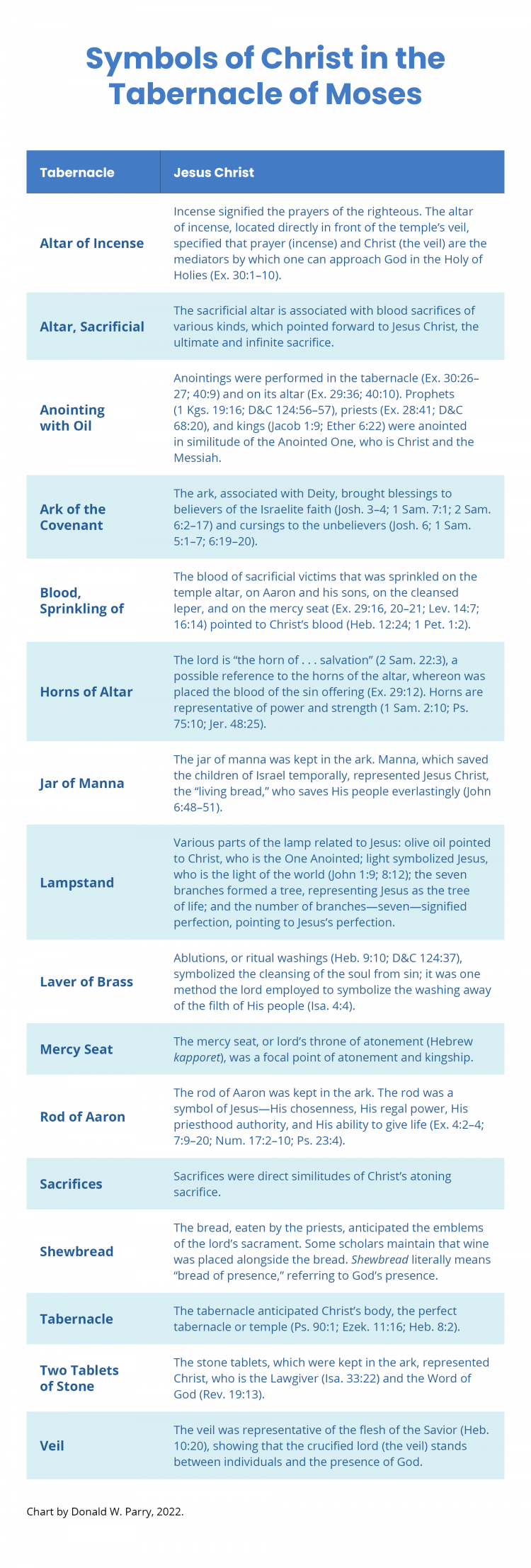You are here
Symbols of Christ in the Tabernacle of Moses
| Title | Symbols of Christ in the Tabernacle of Moses |
| Publication Type | Book Chapter |
| Year of Publication | 2022 |
| Authors | Parry, Donald W. |
| Book Title | The Jesus Christ Focused Old Testament: Making Sense of a Monumental Book |
| Chapter | 48 |
| Pagination | 128-129 |
| Publisher | Book of Mormon Central |
| City | Springville, UT |
Show Full Text
Various components of the tabernacle foreshadow aspects of Jesus Christ’s divine ministry and atoning sacrifice. These components include the tabernacle furniture (laver of brass, altars, lampstand, ark of the covenant), sacrifices (burnt, peace, sin, trespass offerings), foods (portions of sacrificial offerings, shewbread), sacred objects (jar of manna, tablets of the law, rod of Aaron), and diverse parts of the tabernacle (veil, horns of the altar). The rituals and performances (i.e., anointings, washings, sprinkling of blood, laying on of hands), too, typified Jesus Christ and His mission.
The tabernacle building itself, and later the temple of Jerusalem, served as types of Jesus Christ. Many scriptures so testify. The lord told the Jews, who were scattered among the nations, that He would be “as a little sanctuary” to them (Ezek. 11:16). Moses prayed, “lord, thou hast been our dwelling place in all generations” (Ps. 90:1). In his epistle to the Hebrews, Paul called Jesus “a greater and more perfect tabernacle” (Heb. 9:11). And the lord Himself compared Himself to the temple when He said, “Destroy this temple, and in three days I will raise it up.” The Jews, who thought that He referred to the temple of Herod, responded, “Forty and six years was this temple in building, and wilt thou rear it up in three days? But he spake of the temple of his body” (John 2:19–21).
|
Tabernacle |
Jesus Christ |
|---|---|
|
Altar of Incense |
Incense signified the prayers of the righteous. The altar of incense, located directly in front of the temple’s veil, specified that prayer (incense) and Christ (the veil) are the mediators by which one can approach God in the Holy of Holies (Ex. 30:1–10). |
|
Altar, Sacrificial |
The sacrificial altar is associated with blood sacrifices of various kinds, which pointed forward to Jesus Christ, the ultimate and infinite sacrifice. |
|
Anointing with Oil |
Anointings were performed in the tabernacle (Ex. 30:26–27; 40:9) and on its altar (Ex. 29:36; 40:10). Prophets (1 Kgs. 19:16; D&C 124:56–57), priests (Ex. 28:41; D&C 68:20), and kings (Jacob 1:9; Ether 6:22) were anointed in similitude of the Anointed One, who is Christ and the Messiah. |
|
Ark of the Covenant |
The ark, associated with Deity, brought blessings to believers of the Israelite faith (Josh. 3–4; 1 Sam. 7:1; 2 Sam. 6:2–17) and cursings to the unbelievers (Josh. 6; 1 Sam. 5:1–7; 6:19–20). |
|
Blood, Sprinkling of |
The blood of sacrificial victims that was sprinkled on the temple altar, on Aaron and his sons, on the cleansed leper, and on the mercy seat (Ex. 29:16, 20–21; Lev. 14:7; 16:14) pointed to Christ’s blood (Heb. 12:24; 1 Pet. 1:2). |
|
Horns of Altar |
The lord is “the horn of . . . salvation” (2 Sam. 22:3), a possible reference to the horns of the altar, whereon was placed the blood of the sin offering (Ex. 29:12). Horns are representative of power and strength (1 Sam. 2:10; Ps. 75:10; Jer. 48:25). |
|
Jar of Manna |
The jar of manna was kept in the ark. Manna, which saved the children of Israel temporally, represented Jesus Christ, the “living bread,” who saves His people everlastingly (John 6:48–51). |
|
Lampstand |
Various parts of the lamp related to Jesus: olive oil pointed to Christ, who is the One Anointed; light symbolized Jesus, who is the light of the world (John 1:9; 8:12); the seven branches formed a tree, representing Jesus as the tree of life; and the number of branches—seven—signified perfection, pointing to Jesus’s perfection. |
|
Laver of Brass |
Ablutions, or ritual washings (Heb. 9:10; D&C 124:37), symbolized the cleansing of the soul from sin; it was one method the lord employed to symbolize the washing away of the filth of His people (Isa. 4:4). |
|
Mercy Seat |
The mercy seat, or lord’s throne of atonement (Hebrew kapporet), was a focal point of atonement and kingship. |
|
Rod of Aaron |
The rod of Aaron was kept in the ark. The rod was a symbol of Jesus—His chosenness, His regal power, His priesthood authority, and His ability to give life (Ex. 4:2–4; 7:9–20; Num. 17:2–10; Ps. 23:4). |
|
Sacrifices |
Sacrifices were direct similitudes of Christ’s atoning sacrifice. |
|
Shewbread |
The bread, eaten by the priests, anticipated the emblems of the lord’s sacrament. Some scholars maintain that wine was placed alongside the bread. Shewbread literally means “bread of presence,” referring to God’s presence. |
|
Tabernacle |
The tabernacle anticipated Christ’s body, the perfect tabernacle or temple (Ps. 90:1; Ezek. 11:16; Heb. 8:2). |
|
Two Tablets of Stone |
The stone tablets, which were kept in the ark, represented Christ, who is the Lawgiver (Isa. 33:22) and the Word of God (Rev. 19:13). |
|
Veil |
The veil was representative of the flesh of the Savior (Heb. 10:20), showing that the crucified lord (the veil) stands between individuals and the presence of God. |
Terms of Use
Items in the BMC Archive are made publicly available for non-commercial, private use. Inclusion within the BMC Archive does not imply endorsement. Items do not represent the official views of The Church of Jesus Christ of Latter-day Saints or of Book of Mormon Central.
Bibliographic Citation
Subscribe
Get the latest updates on Book of Mormon topics and research for free

